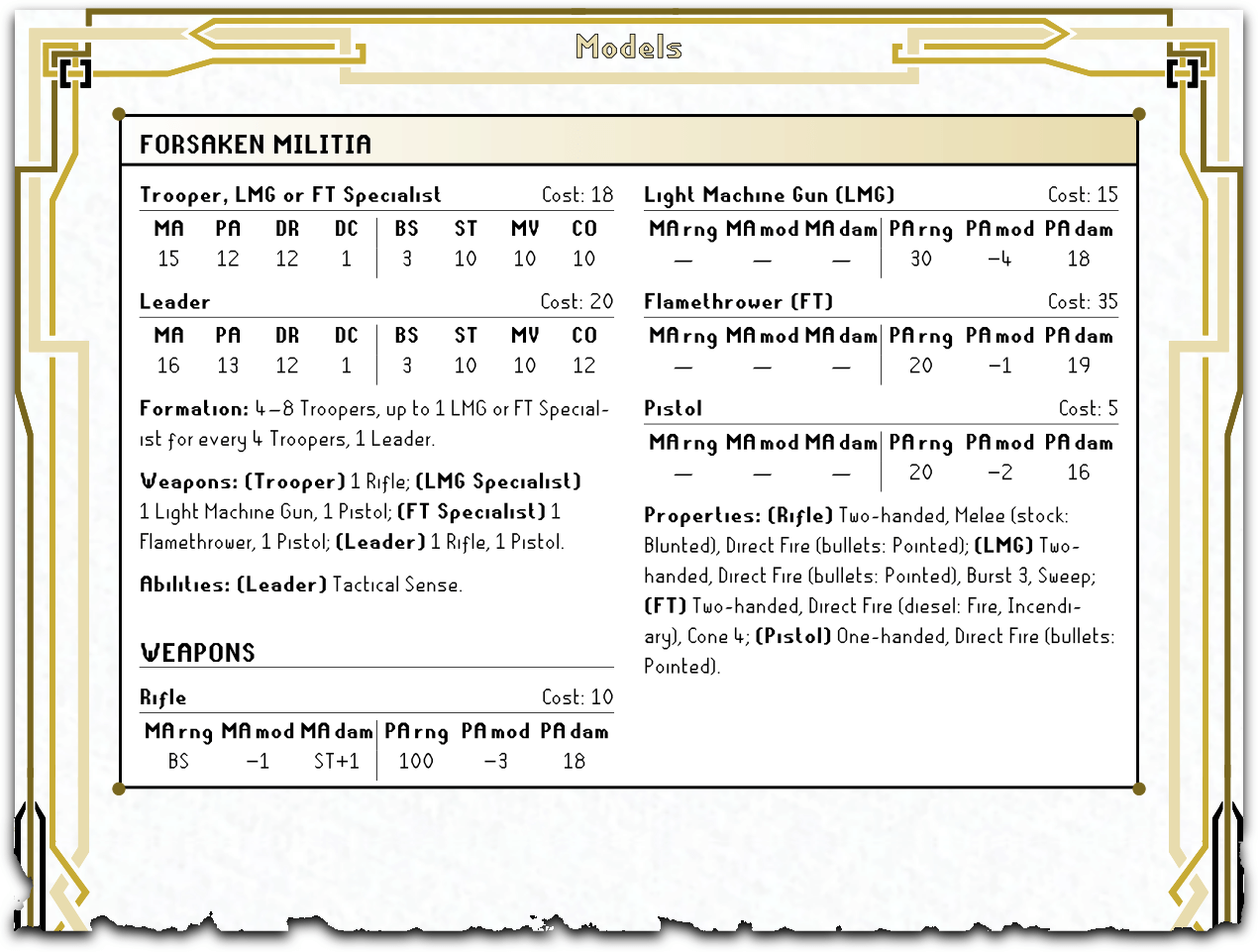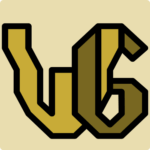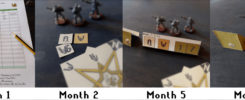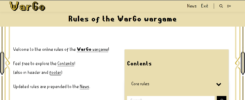
Happy Winter (Summer) Solstice! During these darkest (brightest) days of 2023 that is leaving us, I think it is the best time for a year-end recap about WarGo‘s first months of existence!
Besides, this time of the year has always been a personal favourite for imagining and creating new things; yes, it is time to start writing up the rule book!
Contents
Intro
1. Scale
2. Models
3. Weapons
4. Hierarchy
5. Deployment
6. Command
7. Action
8. Vehicles and Flying
9. Abilities
10. Environment
Outro
Intro
Developing systematic rules that capture the simultaneous command and action of a true WeGo system, yet without leaving space for ambiguity, has been challenging. A main reason for this difficulty was that WeGoWarGo, WarGo for short, is to the best of my knowledge, the first of its kind: skirmish miniature wargame to simulate even infantry battles that will feel as much simultaneous and direct as possible, keeping all players engaged all the time.
As many solutions to difficult problems, the latest “solution” to the simultaneous resolution of actions in WarGo seems rather simple and obvious, prone to levelling statements such as “this is no different to x or y game”. Simpler mechanics, of course, usually hide the efforts that lead to their workaround, and the only thing we can do is to explain and justify the rules in a way that the game makes more sense and becomes more fun for the players.
Besides the novelty reason, I think that the source of such—mainly simplifying—efforts for working around this WeGo system of concurrent deployment, command and action, but also for most of the rest of the mechanics, was that WarGo inherited initially the rules of the Warzone 1st and 2nd edition, as well as of the Chronopia wargame. There were several things there that were too complicated in my vision of an even faster and more direct wargame, and hence this is another reason that many of these mechanics had to be simplified, yet keeping their ideas alive, because they made sense and were fun.
So, let me briefly describe the main evolved dimensions, mainly simplifications that were made, listed essentially as many of the chapters from the WarGo‘s forthcoming rule book:
1. Scale
While the temporal scale remained the same during development, with each Round simulating five seconds of real time, the spatial scaling has evolved. WarGo, being playable at different scales, from 10 mm to 30+ mm miniature height, has to use a relative unit of measurement instead of an absolute one (such as “inches”).
Initially, this unit of length was called the “metre” (m), such as a human would be modelled as at most around 2 m high, and the smallest creature to be modelled as a single entity on a single base would be at most around 1 m, like a dog or a goblin. The use of the metre resulted to the later identified problem that the minimum Body Size (BS) class of 1 m couldn’t accommodate for some still useful lengths which are shorter, for example, weapons that a goblin can wield and are shorter than its BS score, yet significant in length.
This is the reason that the unit of length evolved to the shorter “step” (stp, approximately equal to 0.7 m). In that way, a human would be not higher than 3 stp tall, a goblin 2 stp tall, and that goblin’s short sword could be now modelled as being 1 stp long, that is, of a significant length.
A main reason for this minimal increase in length resolution—from the metre to the step—was that melee combat in WarGo is not a discrete mode that models get interlocked upon base contact. Melee in WarGo is considered just another attack in the continuum from the physical reach with the model’s body to the ranged attack with a projectile. The only difference of melee to projectile attack is that the model uses its physical reach, and commonly a weapon that extends that physical reach, and basically using the model’s STrength (ST) for damage. Note that the physical reach of a model in WarGo is assumed to be equal to that model’s BS, that is, the model’s length of longest dimension.
Returning to the goblin model example, modelling it initially as of BS 1 m meant that any weapon with significant length but shorter than them would not be able to be modelled as extending their physical reach of 1 m, since we couldn’t model any length lower than the unit of measurement itself. By downscaling to the step as the unit of length, a goblin of now BS 2 stp has a physical reach of 2 stp, and can be modelled to reach 3 stp with a weapon of 1 stp length, such as a short sword.
This evolution might seem insignificant, but such small changes in melee range can make the difference between life and death, and the intention for WarGo was to encourage strategic thinking related to the real-world advantage of weapons with longer reach in melee. (You can even model two and three rows of attacking spears in WarGo, as in real-world formations)
2. Models
Inheriting initially most of its mechanics from the Warzone and Chronopia wargames, WarGo models were characterised by 10 traits in their profile. As of now, the profiles were simplified to have 8 traits. Instead of having two traits for internal features (Leadership and mental Power), one trait called COmmand (CO) will capture a model’s overall discipline and mental performance against internal and external challenges.
Another trait that was omitted was the Def (kind of dodge in Melee) ability from Chronopia, since it was adding a lot of addition, subtraction and negation when calculating the final attack modifier, without adding a lot of fun to the process. Nevertheless, Dodge will remain as an Ability that only specific units specialised in melee may have.
3. Weapons
Weapon profiles were also simplified. They started by inheriting the five range bands of Warzone, they were then reduced to two as in Chronopia, and they finally went down to a single Projectile Attack (PA) range, but also a separate triplet of scores for use in Melee Attacks (MA).
In that way, a purely melee weapon such as a sword will have null PA scores, a purely projectile weapon such as a pistol will have null MA scores, but there are also weapons that can have both triplets of scores, such as a rifle that can be also used in melee with its stock or a bayonet, and an axe that can be both thrown and used in melee.
Different modes of attacking, for example, an assault rifle’s burst and auto modes in addition to its semi-auto, can be modelled by additional lines in the weapon’s profile, since they can have different attack modifiers, effective ranges and even damage scores.
4. Hierarchy
The chain of command in WarGo hasn’t evolved much since its inception. That is, the Player is thought to be the Commander of the force. Under the Player/Commander, we have the Individuals and Team Leaders. Some Individuals, especially with higher CO score might operate as higher in hierarchy than Team Leaders due to Abilities they may have. Further down the hierarchy, we have the Team Members.
Players/Commanders issue commands to the Individuals and Leaders, Individuals may re-issue commands to Leaders of lower CO, and the same can be done by the Leaders to single Team Members.
This elasticity of the command hierarchy was meant to simulate the fact that reactions and decisions on the field may partially override an initial command by Commanders, since the bodies on the field are the ones living the action in real time and not the Commanders. Soldiers, not Commanders, are the ones who struggle between enemies, orders and self-preservation instincts!
5. Deployment
This has also remained pretty much the same, with the use of markers for secretly deploying Individuals and Team Leaders, together with an utmost equal number of bluff markers to confuse the opponents. This “fog of war” type of Deployment was intended to simulate the limited and obscured information that Players/Commanders have when they position their forces simultaneously just before combat commences.
Nevertheless, deployment was enriched with the Ability of Infiltrators, who can approach enemy lines much closer, and later, with more information about enemy positions. That is, infiltrators are deployed in a second, Infiltrator Deployment step, after the players machinate, disclose and position their often noisy and exposed main forces during the first, Main Deployment step.
6. Command
The Command Phase has evolved in an interesting way. Initially, it was only a Command Phase of machinating and disclosing the available commands. The initials from the names of the five possible commands formed the WarGo name (Wait, Attack, Rally, Go, Overpass). For various demands and reasons, the Command Phase was split into three steps/sub-phases. In each step, the commands are issued secretly, and they are then disclosed before moving to the next step:
- Command Action step. This is the main sub-phase, when you issue a command to each of your Individuals and Team Leaders.
- Command Coaction step. Team Leaders, being in the field, can make exceptions to the main command that has been issued to them by the Players/Commanders in the first step. They can order specific Team Members to do something else in parallel, as a coaction. The cost/risk is that the new commanded action of these Team Members might be missed due to its overriding, hasty, responsive nature (note that the Players have disclosed to everyone their main intentions during step 1). The commanded coaction will not be carried out if the Leader who attempts to issue it fails in a CO test. This step was added later, to enable more flexibility, such as the ability to simulate a team that is moving under the supporting fire of a “coacting” heavy gun specialist in the team.
- Command Reaction step. Units that have been issued to Wait in the Command Action step 1, can be reissued a new command, after knowing all the Actions and Coactions of the rest of the Units from the previous two steps. The cost/risk again here is that if the Leader or Individual fails in a CO test, the Unit will miss the new commanded reaction, simulating the difficulty and frequent inability to react in a timely, disciplined and coordinated way to the actions of the other Units during the short and commonly intense, 5-sec window of the Round.
There have been different ways to accommodate the Command Phase, as I have already explained in a previous Progress post. There have been two more recent changes that are not covered in that post. First, to drop the specification of Distance from the Command Directives.
Second, to re-order the Command Phase steps, such that Reaction is last, so that even Coaction is known before reacting. This was important especially since it is expected that Coaction is commonly ordered to Team Members with usually heavy or critical output, and hence I thought that the Wait Action would better reward waiting players a bit more, given the cost/risk of staying idle at a Round of a failed CO test.
The recent omission of specifying the distance became possible by the adoption of a simple yet realistic and direct rule: Target Priority. Target Priority was taken from Warzone, and it meant that a model would target its nearest enemy in sight, simulating the urge to attack the greater threat that a spatially closer target is posing. In that way, now also in WarGo, we don’t need to specify distance, since a model just attacks the closest target. Of course, there will most likely be an Ability that features a Tactical Sense of targeting models further away, but it will now be the exception and not the rule.
Additionally, target priority in WarGo will not only be spatial, but also temporal, as I explain next for the simultaneous resolution of actions.
7. Action
Very soon during development, playtesters and I realised that it is very ambiguous and prone to cheating and working around if players just play simultaneously their instructed commands: you would see what someone else does, then change appropriately, the same does the opponent, and so on.
Thus, the initial measure to limit this ambiguity was to first play only the Units that were instructed to Go, but only the ones who were targeted by Attacks or other Effects, or their trajectory would be interrupted by the movement of another Unit. The attackers and others targeting such a Unit, could specify any point on the trajectory of the moving Unit when they could interrupt it and unleash the attack, effect or movement.
This was still ambiguous, though. Imagine several Units in an interconnected web of such interactions, and it was also cumbersome for our memory and tracking to move the models of a Unit and stop them, and then remember where we were left… Let alone the question of how were the models moving, for example, one behind the other in a line, some covering the others and moving in close formation, or what? I felt that it’d be good for players to feel that when they touch one of their models, they move it to its final destination, and that’s it, no touching again until next Round.
It was then clear that stricter measures had to be taken, with the aim of making them strict enough, yet allowing some freedom for last-moments-decision. In that way, we’d expect that any player, given the current models on the tabletop and the same specific commands, would execute more or less the same actions. This was another reason that Target Priority, as explained in the previous section, was so handy. Temporal priority, in specific, meant that a model that is instructed to target to a specific direction, either with an attack or other effect, must do that immediately at the closest target, and not to wait while watching the trajectory of the targets moving around. This is the temporal equivalent of the nearest-threat principle, but in time and not in space.
These thoughts lead to the following steps for systematising the Action Phase:
- Any models that are commanded to Attack must do so if they have line of sight, and they must do that to their nearest target, according to Target Priority. Apply usual penalties if the target is commanded to Go at the same time. This simulates the fact that although bringing down an axe, or pulling a trigger, is faster than the movement of a body, still we consider the target moving, which makes it more difficult to hit. Attackers who don’t have line of sight to targets can either make Speculative Attacks if they handle an Indirect Fire weapon, or they can make Suppressive Attacks targeted to some point on the terrain.
- Units who are Commanded to Go, may execute their whole movement. Moving through zones of Suppressive Attacks is allowed only under each model’s successful CO test. All models move, even if their Damage Capacity (DC) score has been reached by Damage Points received during step 1. This simulates that even with critical wounds a moving body usually has the constitution, reflexes and momentum to carry on its already started movement. This means that these wounded targets might attract more attacks in the next step, before dropping down.
- Models that were commanded to attack but haven’t done yet, are given another opportunity to do so, after all movement on the tabletop has been simultaneously executed in the previous step 2. Again, the same penalty applies due to moving targets. This is done to simulate that despite the discretisation of targeting only before and after any movement of models occurs, essentially we model a simultaneous movement and firing. We make here the simplifying assumption, which seems realistic, that it is physiologically and technically almost infeasible to target models that are becoming visible for very short time during their trajectory, for example, as they pass through an opening gap, especially in the tension and threat of a battle. Again here, potential attackers still without line of sight to targets can make Speculative or Suppressive Attacks, the latter lasting until the end of the next Round.
- Remove fallen models, and automatically make Panic Tests based on each Unit’s total DC. Units that were already panicked during this Round can automatically make a Rally Test.
This last part of automating the Rally Test was added very recently, to enable the addition of a different Command in the list of five available Commands in WarGo. That is, there was a need to include an Attack-and-Go/Go-And-Attack command, which was brought forth during the creation of the rules for Vehicles, which usually can move and fire, since they are usually a collaboration of models with different roles.
This now-called “Reach” command took the R- place of Rally from the WarGo name formed by the initials of the five possible commands. Another reason to include that command of combined move/attack, with both actions suffering penalties because of doing both at the same 5-sec duration of a Round, was to more fluently and directly model the charge into melee move. In the previous version of the rules, players had to remember, or use a marker to remind them, which models had moved in the previous Round, so that if they are attacking in melee in the current Round, they would receive a BS bonus to the damage of the melee weapon (simulating that charging models channel their momentum onto their blows). Having to realise a charge’s effect one Round later removed a lot of fun from this dynamic action. With the new Reach Command, a charge is realised directly by models who move and then Attack in melee.
Finally, Overpass was renamed Operate, a Command for doing any other thing besides movement and attacks, from dismantling a mounted HMG to casting a spell. Due to their special nature, Operate commands will have to be explained in a case-by-case manner. Note that in the steps of the Action Phase, Operate might be acting during the whole Round, such as forming a Wall of Shields according to the relevant Ability, or it might act in a specific step, such as to Rally Others according to an Ability that an Individual can have for panicked Units by rolling a CO test with that Individual’s higher CO score at the last step of the Action Phase.
8. Vehicles and Flying
These rules were developed very recently, upon the latest version of the main rules, so no great evolution on them. I tried to make them as much as possibly based on these main rules, minimising exceptions, etc. I think they are direct, furious and fun, especially the Vehicle Hits part!
9. Abilities
Abilities are also fun, of course, from Sniper, to Zombie, to Berserk! There is this idea to write expansions for different genres and worlds, which will accommodate different Abilities adapted to each setting, etc. Let’s see…
10. Environment
Similarly to the Abilities, the interaction of the models with their Environment can lead to lots of fun and strategic planning during play. Examples of environments are woodlands, deserts, water bodies and even buildings. These again are as generic as possible, that is, using the logic and intuition of the main rules, and just making clear the advantages and disadvantages that each environment can impose to different models.
Outro
As the game itself, this post evolved from a simple holiday greetings post to a rather detailed log of the major changes during the first months of WarGo development!
Even if you didn’t keep up reading it, this post will be at least useful to me, like an account of what has been done during the year, having them written down here. Moreover, if you didn’t keep up reading, I hope you will keep up with the development of the wargame, since it will almost certainly take longer than expected to finish up the rule book. Don’t worry, though, the rule book will be much more succinct than this post!
Main reason for taking longer is that it would be cool to have photographs and artwork in it with miniatures and worlds created by myself. This means that even if the rule book’s text is written, its release will wait for some world design, some 3D printing, some painting, some making of terrain, some playing and video shooting and photographing, some…
Phew, what a mutlidimensionally wonderful hobby, ain’t it? I hope we all enjoy it during the forthcoming year, full of health, meeting fellow players and friends to share the fun of it! Happy New Year!
Best regards,
Danis, the WarGo designer
Make WarGo, not war..!



